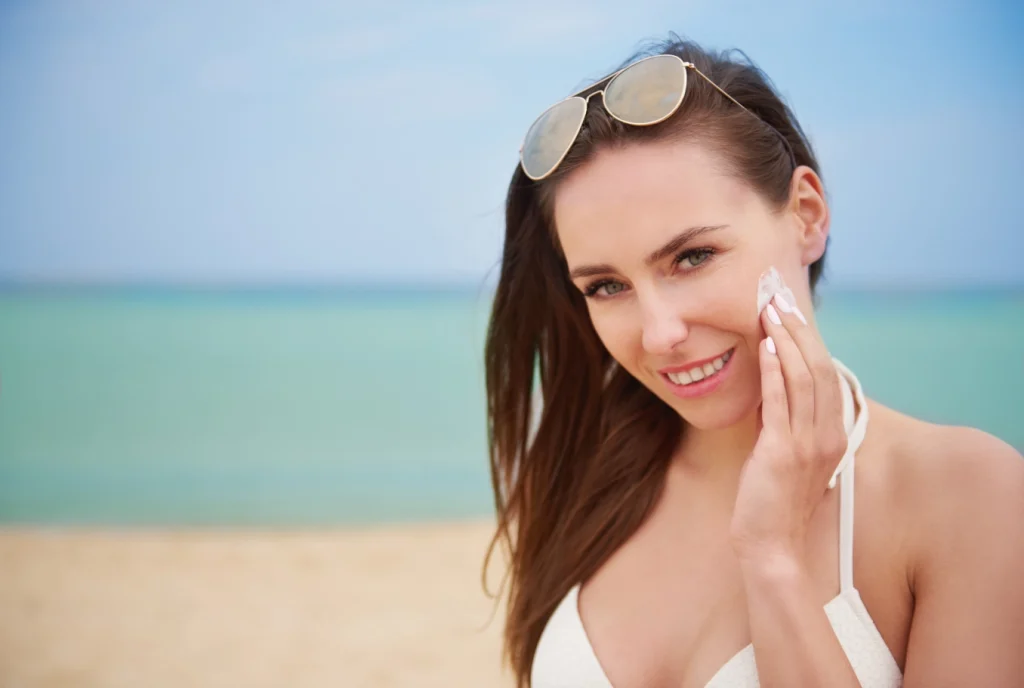If you live in Dubai, you already know the sun is a full-time job. But UV intensity and ambient heat/humidity still change by season — and that should shape how and when you treat acne scars and PIH. In Fitzpatrick IV–VI, timing matters even more: you’ll get better results with fewer setbacks when you sequence modalities around UV peaks and give your skin longer “cool-down” windows.
Key truth: Dubai’s UV is high all year, with very high to extreme peaks from March through August (often UV 10–12+) — so your protocols must be pigment-safe year-round, and extra careful during these months.
Why seasons matter for Fitz IV–VI in Dubai
PIH risk tracks with light exposure (including UVA and visible light), not just heat. Tinted, iron-oxide sunscreens can help protect against visible light–induced pigment.
Sweat + heat amplify inflammation after procedures, which can worsen pigment in melanin-rich skin — so we tweak aftercare and spacing in hotter months.
Collagen remodeling (microneedling/RF) is biologic: gains appear over 6–12 weeks, so planning a series around UV peaks keeps momentum without over-irritation. (That’s why we often alternate peels/facials between remodeling sessions.)
Microneedling (Biosome Skin Pen): year-round cornerstone
What it does: controlled micro-channels → new collagen → smoother rolling/boxcar scars; great safety profile for skin of color when parameters and aftercare are right. Evidence consistently supports microneedling for atrophic acne scars across a 3–5 session series.
Season tips:
Summer (Mar–Aug): stay conservative on depth at first; emphasize SPF reapplication q2h outdoors and hats/shade. Mineral makeup usually day 2 is fine if skin’s calm.
Winter (Nov–Feb): you can progress settings a touch faster if the skin tolerates, but broad-spectrum habits don’t change.
Add-on: PRP Face can enhance clinical improvement and satisfaction without increasing serious adverse events vs microneedling alone, per meta-analysis.
RF Facial Contouring (VFR): when texture meets early laxity
What it does: insulated needles deliver radiofrequency into the dermis → remodeling + subtle tightening. Reviews in skin of color show low rates of dyspigmentation when parameters are tailored and aftercare is strict.
Season tips:
Summer: we may favor lower energy / fewer passes, meticulous cooling, and longer gaps between appointments.
Winter: often the best window to start a VFR series if you spend lots of time outdoors during summer.
Combinations: VFR alternated with microneedling can work well; some centers also combine with fractional lasers, but we prioritize pigment-safe paths first.
Chemical Peels & Medical Facials: tone control between remodelers
What they do: superficial lactic/mandelic peels and medical facials support PIH clearance and barrier function; they’re our “between-sessions” tools in Fitz IV–VI. Small prospective data and reviews support lactic/mandelic for pigment with good tolerability in darker skin.
Season tips:
Summer: more enzyme-led medical facials or very gentle peels; stricter post-procedure heat avoidance; no picking flaking skin.
Winter: you can run slightly stronger superficial peels if indicated, still with medical supervision and sun protection.
PRP Face: regenerative add-on, especially helpful in summer
Because PRP is autologous and anti-inflammatory, many patients pair it with microneedling during high-UV months to support a smoother recovery; the best evidence base is MN±PRP (less so RF+PRP, which is emerging).
Season-by-season booking map
WINTER plan (Nov–Feb): UV 6–9; outdoor life still sunny
Month 1: Microneedling (Biosome Skin Pen) #1 ± PRP Face – Medical Brightening Facial (enzyme-led) at week 3
Month 2: Microneedling #2 ± PRP Face – Mandelic or Lactic Peel at week 3 if PIH present
Month 3: Microneedling #3 or step up to RF VFR #1 if early laxity is a goal
Why winter: slightly milder UV + pleasant outdoor temps make it easier to avoid peak sun post-procedure, but keep broad-spectrum habits exactly the same (reapply q2h outdoors).
SUMMER plan (Mar–Aug): UV 10–12+; heat/sweat high
Month 1: Microneedling #1 ± PRP Face (morning slot) – Hydrating Medical Facial (no acids) at week 3
Month 2: Microneedling #2 (parameters per tolerance) – consider Enzyme Facial + LED at week 3
Month 3: VFR #1 or Microneedling #3, depending on laxity and lifestyle; keep peels ultra-conservative or swap for facials to protect barrier
Why summer caution: heat + UV elevate PIH risk; we extend no-sweat windows, prefer early-day appointments, and lean on tinted, iron-oxide SPFs for visible-light protection.
SHOULDER months (Sep–Oct & late Feb–Mar): transition with flexibility
If your calendar means you must treat then, we can blend winter-level progression with summer-level aftercare. The non-negotiable: reapply sunscreen every two hours outdoors (AAD guidance).
Aftercare that never changes (Dubai reality)
Broad-spectrum sunscreen and reapply q2h outdoors; immediately after sweating or swimming. (AAD, ACS)
Prefer tinted / iron-oxide formulas to help block visible light, which matters for PIH/melasma.
Avoid sauna/hot yoga/intense workouts for ~48 hours post-needling/peels to limit heat-driven inflammation.
Don’t stack strong actives (retinoids, AHAs/BHAs) in the first week unless advised.
Service chooser: what to book, and when
Microneedling (Biosome Skin Pen): start anytime; anchor of your series for rolling/boxcar scars; 3–5 sessions at 4–6-week spacing. Add PRP Face when you want faster perceived quality gains or you’re treating in high-UV months.
RF Facial Contouring (VFR): add when texture + early laxity coexist; winter is a great time to start, but it’s Fitz IV–VI-safe year-round with conservative parameters.
Chemical Peels/Medical Facials: use to control PIH and maintain glow between remodeling sessions; in summer, prefer enzyme facials or very gentle peels.
Note on Cynosure Elite+ (LHR): our laser hair removal platform — not a first-line tool for acne scars or PIH in our protocols.
